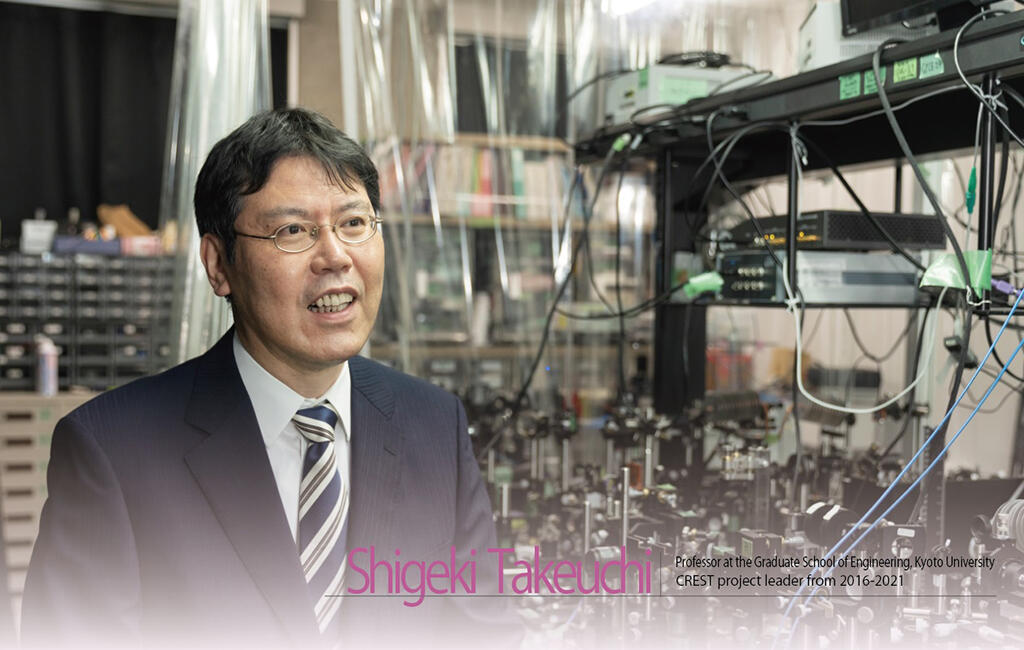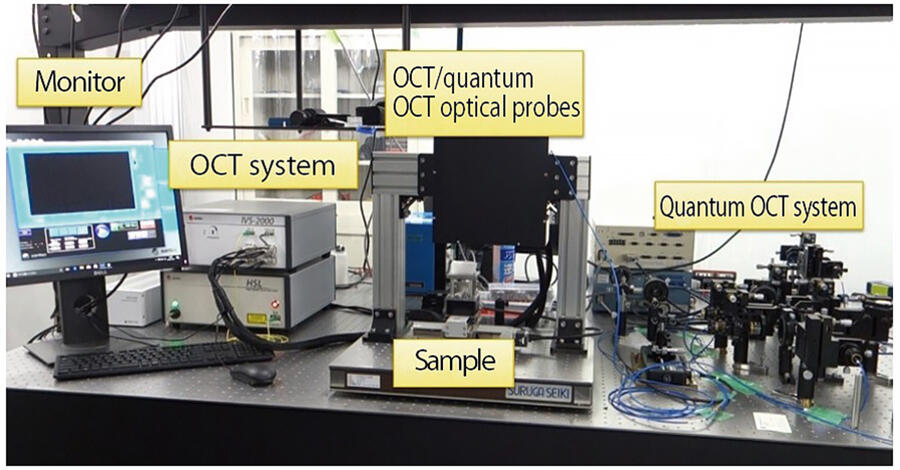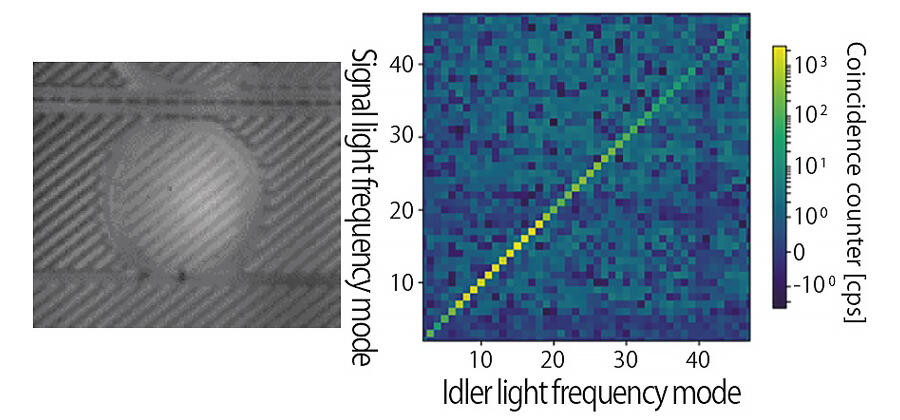Apart from the areas it is also in use, Quantum technology is expected to be utilized in the fields of measurement and sensing, where it is anticipated to have a wide range of applications, from the medical sphere to space observation. However, for actual implementation in society as measurement technology, not only is it necessary to verify the theories behind it, but the development of devices and detectors is also crucial. Professor Shigeki Takeuchi of Graduate School of Engineering, Kyoto University, has developed a broadband frequency quantum entangled photon pair source, along with quantum optical coherence tomography (quantum OCT) that incorporates the light source. His goal is to establish a measurement technology with an unprecedented degree of precision by controlling each photon individually.

A track record in non-destructive observation of rice ― Immersion in PRESTO research
While it is said that the development of a general-purpose quantum computer will still take quite some time, some areas of quantum technology are further ahead than others in terms of social implementation. One of those areas is quantum sensing and measurement. For example, even the slightest external influence can cause a quantum state to collapse, but the flip side of this quality is that it can be applied in high-precision sensors, which can detect changes in the external environment by looking at quantum states. Innovative measurement technologies that take advantage of these unique quantum properties are expected to be developed.
From this background, Professor Shigeki Takeuchi of the Graduate School of Engineering, Kyoto University, who leads the CREST project on "Research on the efficient generation of the broadband frequency entangled photons and their applications," aims to establish a new quantum optical measurement technology that uses quantum entangled photons. After conducting research in graduate school on the generation and detection of phonons using superconducting devices, Professor Takeuchi joined Mitsubishi Electric Corporation in 1993 with the desire to do research on quantum devices. While there, the first assignment he was given was to search for a "new research theme," and at the same time, as part of the search for new business opportunities, he was asked to conduct research related to rice during the first year in the company.
Although he had never done any research related to rice, Professor Takeuchi was determined to get a deeper understanding of the rice cooking process, and he made his own glass tubes and holders in order to cook a single grain of rice. "In a joint industrial-academic research project, we were able to use one of the two nuclear magnetic resonance (NMR) micro-imaging devices that existed in Japan at that time, and succeeded in non-destructive real-time observation of the process of starch gelatinization inside grains of rice." This research on rice led to the installation of the "umami (flavorful) cooking" button on Mitsubishi Electric's line of electric rice cookers.
Professor Takeuchi relates that, "While at first glance, this may seem to have nothing to do with quantum technologies, the experience I obtained in controlling nuclear spins and achieving high-speed imaging through phase relaxation has been useful to my current research." A few years later in 1995, he proposed the development of a quantum computer using photons, which he designated as his "new research theme." At the age of 27, he became the youngest researcher ever to be selected for the JST-PRESTO program, and began to immerse himself in the quantum research he had long been wanting to explore. "In the research area of PRESTO, I was fortunate to be guided by a group of wonderful professors, including the mentor of the research area, Prof. Yoshimori. I also received support for such things as overseas stays, for which there was no system in place at the time in JST-PRESTO." In 1998, Professor Takeuchi was the first in the world to demonstrate a single-quantum quantum algorithm, and has steadily produced a number of achievements since, including developing a "quantum entanglement filter," which is an optical quantum circuit that extracts light while maintaining the entanglement of two light quanta, and a high-intensity single-photon source.
Development to meet the needs of society: Achieved higher speed in fundus examination equipment
Now that he was able to work with light quanta experimentally as he had hoped for, Professor Takeuchi set his sights on applying this technology to quantum sensing and measurement. In conventional optical sensing and measurement, irradiation with high-intensity light is necessary to obtain detailed measurements with high resolution, but as this would destroy the sample, the only choice has been to use weak light and take a long time to perform the measurements. "In optical measurement, the greater the amount of light, the higher the accuracy, but in theory, quantum light may ultimately be able to achieve the same degree of accuracy with one-billionth of the amount of light. Even without going that far, it may be possible to perform high-resolution analysis in a shorter time," he explains.
First, by detecting differences in the path along which light travels due to differences in the "refractive index" and "thickness," Professor Takeuchi came up with and realized an " entanglement-enhanced microscope" that uses photon pairs in a quantum entangled state as the illuminating light for a differential interference microscope used to observe transparent specimens, and demonstrated that it can detect a thickness of about 100 atoms. The team then explored further possibilities for optical measurement using quantum entangled light and came up with optical coherence tomography (OCT), which is used to photograph cross-sectional images of the retina for examination of the fundus and other purposes.
OCT is widely used for observation of the fundus of the eye, as well as for inspections in production lines among other purposes. However, an issue with existing OCT technology is that the resolution is greatly reduced because the speed at which the light travels through the medium, such as ocular tissue, varies depending on the wavelength. However, quantum OCT, which uses quantum entangled light as its light source, was thought to have no degradation in resolution in theory.
Professor Takeuchi and his team successfully generated quantum entangled photon source with the world's largest frequency bandwidth and showed in basic experiments that it is possible to achieve a high resolution of 0.54 micrometers, which surpasses the existing OCT resolution record of 0.75 micrometers (a micrometer is one millionth of a meter). It was also confirmed that dispersion has almost no impact on quantum OCT. Professor Takeuchi says with a laugh, "We were able to achieve high-resolution quantum OCT as expected, but it took very long time, eight hours to take one image." The reason for this was the insufficient number of quantum entangled photon pairs that could exist over a wide frequency bandwidth.
Realizing that this would make quantum OCT difficult to put to practical use, Professor Takeuchi launched research at CREST in 2016 to realize more powerful quantum entangled light sources and to establish innovative quantum optical measurement technologies. To generate quantum entangled photons more efficiently, his team developed a slab waveguide chirped quasi-phase-matched device that confines light in a planar fashion, as well as a ridge waveguide chirped pseudo-phase-matching device that confines light in both horizontal and vertical directions.
As a result, two types of high-efficiency quantum entangled photon sources were developed: a slab device with 300 times the generation efficiency of bulk crystals, and a ridge device with more than 600 times the efficiency (Fig. 1). Furthermore, in addition to the quantum entangled photon source, quantum OCT that incorporates a high-speed counting system using a superconducting photon detector was developed, and the image acquisition time has been improved by a factor of 300 or more to approximately 90 seconds while maintaining high resolution.
Fig. 1: Development of a "broadband frequency entangled photon" source

The results of the experiment showed that the slab waveguide device and the ridge waveguide device achieve quantum entangled light with generation efficiency rates 300 and 600 times higher than those of bulk crystals, respectively, which was much higher than anticipated.
In addition, a prototype hybrid OCT system was created that incorporates quantum OCT into an existing OCT system. (Fig. 2) Explaining the benefits of the system, Professor Takeuchi states that "creating a hybrid system allows us to observe a large area of the target sample using existing OCT, which does not have high-resolution capabilities but is superior in terms of speed, and then use quantum OCT to closely examine the areas that we want to observe at a particularly high resolution."
Fig. 2: Hybrid OCT system

The research team's accomplishments are not limited to the field of academia. One of their noted contributions to scientific and technological innovation is the realization and control technology of on-chip ultra-broadband frequency quantum entangled photon sources. Professor Takeuchi's research team has newly developed on-chip highly nonlinear ring resonators and on-chip high-frequency modulators, which are hybrid silicon and organic polymer devices. (Fig. 3) These entangled photon sources are expected to dramatically shrink the size of quantum sensing and quantum communications devices. We can look forward to further development of these devices in the future, including verification of the theory and improved durability for implementation in society.
(Text: Shinji Moribe, photo: Hideki Ishihara)
Fig. 3: Broadband on-chip quantum entangled photon source





